Some people report that they have encountered the CNSS File System Filter blue screen error on their PC. Have you also encountered the same error? This post of MiniTool Partition Wizard provides some useful solutions to help you fix the error with ease.
What Is the CNSS File System Filter Error?
The CNSS File System Filter error is one of the most common BSOD errors. It can also be called the STOP 0x000000A4 error.
Generally, the Bug Check 0xA4 CNSS_FILE_SYSTEM_FILTER error shows up after a user has installed new software or hardware. However, different people may encounter different error forms. Here are two main forms it may show:
- The CNSS_FILE_SYSTEM_FILTER bug check has a value of 0x000000A4. This bug check indicates that a problem occurred in the CNSS File System Filter.
- A problem has been detected and Windows has been shut down to prevent damage to your computer. The problem seems to be caused by the following file: STOP Error 0xA4: CNSS_FILE_SYSTEM_FILTER.
Causes of the CNSS File System Filter Error
There are so many factors that may cause BSOD errors, including the CNSS File System Filter error. Here I listed some of the most common reasons:
- Outdated device drivers or Windows.
- Viruses or malware on PC
- Wrong configurations
- Software conflicts
- Damaged disk or corrupted RAM
- Corrupted system files
- Full nonpaged pool memory
- Outdated BIOS
- Too many caches on the computer
How to Fix the CNSS System Filter Error?
How to fix the CNSS System Filter error? Don’t worry! This section shows some effective methods for the Bug Check 0xA4 CNSS_FILE_SYSTEM_FILTER error. You can try them one by one until you fix the error on your PC successfully.
To try the below methods, you need to boot your PC into Safe Mode. Here’s a guide for entering Safe Mode: How to Start Windows 10 in Safe Mode (While Booting) [6 Ways].
Method 1. Update Drivers and Windows OS
Outdated Windows and device drivers may cause the CNSS_FILE_SYSTEM_FILTER BSOD easily. So, you can try updating Windows and device drivers to the latest version to help you fix the STOP 0x000000A4 error.
To update Windows, you can follow the guide in this post: Update Windows 11/10 to Download & Install Latest Updates. To update drivers, you can refer to this post: How to Update Device Drivers Windows 10 (2 Ways)
Method 2. Disable Invalid Driver or Roll Back to Default
If updating drivers doesn’t work for you to fix the CNSS_FILE_SYSTEM_FILTER BSOD error, you can try disabling or rolling back to default. To do that, you can follow these steps:
- Press the Windows and R keys to open the Run window.
- Type “devmgmt.msc” in the box and press Enter.
- Expand the category that includes the driver you want to disable or roll back.
- Right-click the driver and select Properties.
- Go to the Driver tab, and then click the Disable Device or Roll Back Driver button.
- Follow the on-screen instructions to complete the process.
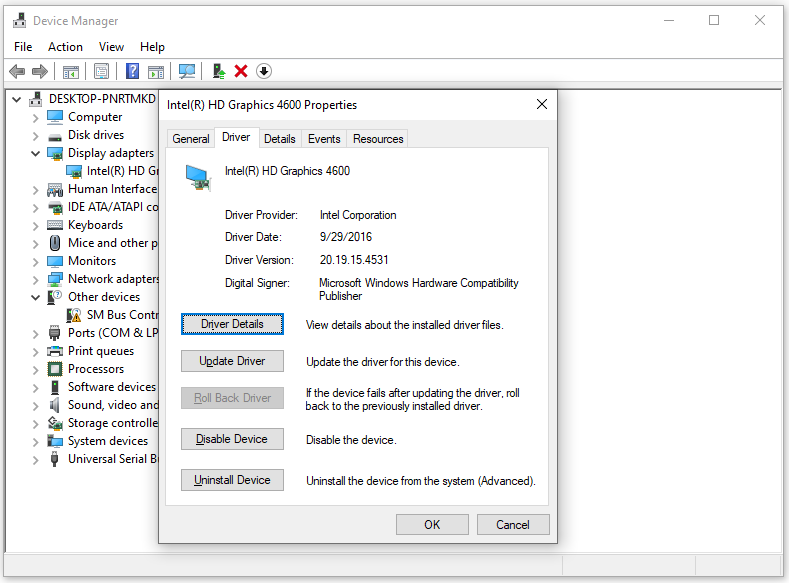
Method 3. Scan for Viruses or Malware
If you suspect that viruses or malware are on your PC, causing the CNSS_FILE_SYSTEM_FILTER BSOD error, you can perform a virus scan on your computer. Here’s the way:
- Go to Settings > Update & Security> Windows Security, and then select Virus & threat protection.
- Under the Current threats section, select Scan options.
- Select one of the scan options: Full scan, Custom scan, or Microsoft Defender Offline scan.
- Next, select the Scan now button.
- Once done, check if the issue is fixed.
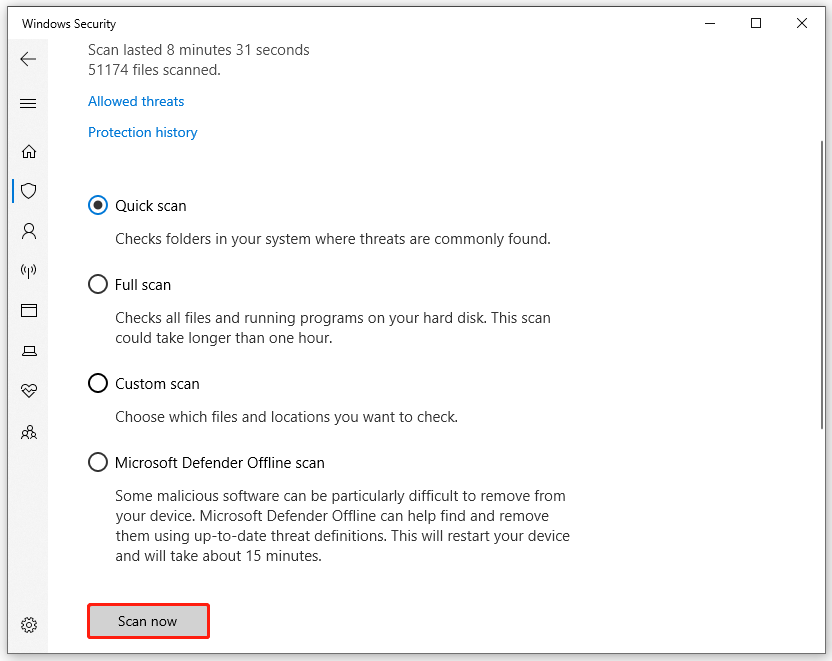
Method 4. Uninstall Similar Applications to Avoid Software Conflict
Sometimes, similar applications on one PC may conflict. So, if you have installed similar applications, you can try uninstalling them to fix the STOP 0x000000A4 error. To do that, you can navigate to Settings > Apps, scroll to select a similar app, and then click on the Uninstall button.
Method 5. Run Windows Blue Screen Troubleshooter
When you encounter the CNSS_FILE_SYSTEM_FILTER BSOD error, running the Windows blue screen troubleshooter is also a good choice.
To run the Windows blue screen troubleshooter, you can press the Windows and S keys to open the Search window, type “blue screen“, and then click the Find and fix bluescreen problems option under Best Match. Next, follow the on-screen steps to complete the process.
Method 6. Disable Fast Boot
Enabling fast boot on your PC causes the Windows system to put your PC in hibernation when you turn it off. This means that when you boot up Windows again, it will resume working from hibernation instead of starting from scratch.
However, if you turn off your PC when it encounters errors, these errors may stay in your system and reappear the next time you boot up your PC.
Disabling fast boot can allow your PC to perform a full self-test and fix some errors on the next boot-up. So, if you encounter the STOP 0x000000A4 error, you can try disabling fast boot to fix this error. Here’s the guide:
- Press the Windows and R keys to open the Run window.
- Type “powercfg.cpl” in the box and press Enter.
- In the Power Options window, select Choose what the power buttons do link from the left pane.
- Then click on the Change settings that are currently unavailable link.
- Next, under Shut-down settings, uncheck the box of Turn on fast start (recommended).
- After that, click Save changes, and then restart your PC.
Method 7. Run SFC and DISM
As mentioned earlier, if there are any corrupt system files on your PC, you may also encounter the CNSS_FILE_SYSTEM_FILTER BSOD error easily. In this case, you can run SFC and DISM on your computer to fix the error.
Both System File Checker (SFC) and Deployment Image Servicing Management (DISM) can assist you in repairing system file corruption on your computer. You can run them by doing the following:
- Open the Search window, and then type “command prompt” in the search box.
- Click Run as administrator under the Command Prompt app.
- Type “sfc /scannow” and press the Enter key.
- After the process is completed, type “Exit” and press the Enter key to close the Command Prompt window.
- Once done, restart your computer to check if the error is fixed. If not, proceed by initiating a DISM scan.
- Run the Command Prompt as administrator on your computer again.
- Then type “DISM.exe /Online /Cleanup-image /Scanhealth” and press the Enter key.
- Type “DISM.exe /Online /Cleanup-image /Checkhealth” and press the Enter key.
- Type “DISM.exe /Online /Cleanup-image /Restorehealth” and press Enter.
- Type “Exit” and press the Enter key to close the Command Prompt window.
- Once done, restart your computer to check if the STOP 0x000000A4 error is fixed.
Method 8. Run the Windows Memory Diagnostic Tool
As the memory issue can also cause the CNSS File System Filter error, you can try running the Windows Memory Diagnostic tool to fix this error. Follow these steps to accomplish this operation:
Step 1. Open the Run window.
Step 2. Enter “mdsched.exe” into the box and press the Enter key.
Step 3. A window will pop up. You can choose the first option Restart now and check for problems (recommended).
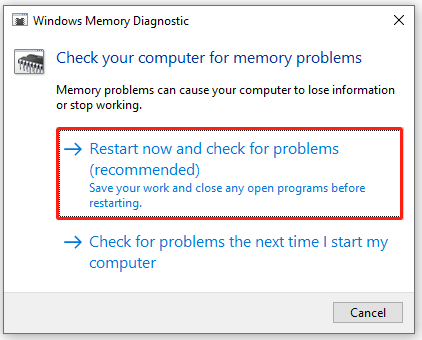
Step 4. Once the process is complete, check whether the STOP 0x000000A4 error has been resolved.
Method 9. Add New Physical Memory to the Computer
If the Bug Check 0xA4 CNSS_FILE_SYSTEM_FILTER error is caused by the nonpaged pool memory being full, you can try adding new physical memory to the computer to fix this error. This can increase the quantity of nonpaged pool memory available to the kernel.
Method 10. Check Hard Disk Drive via MiniTool Partition Wizard
If there are errors on your disk, you can also encounter the Bug Check 0xA4 CNSS_FILE_SYSTEM_FILTER error. In this case, you can use a tool to scan and fix the errors on your hard disk drive.
For doing that, I recommend the MiniTool Partition Wizard to you. It is a comprehensive third-party partition management tool. You can use the Check file system and Surface Test functions of it to scan and fix the errors on your hard disk drive.
Here’s the guide for Check File System:
MiniTool Partition Wizard FreeClick to Download100%Clean & Safe
- Download and install the MiniTool Partition Wizard on your computer. Then launch it.
- Highlight the target partition and click on the Check File System option from the left panel.
- Select the Check & fix detected errors option, and then click on the Start button.
- Click Yes in the pop-up window.
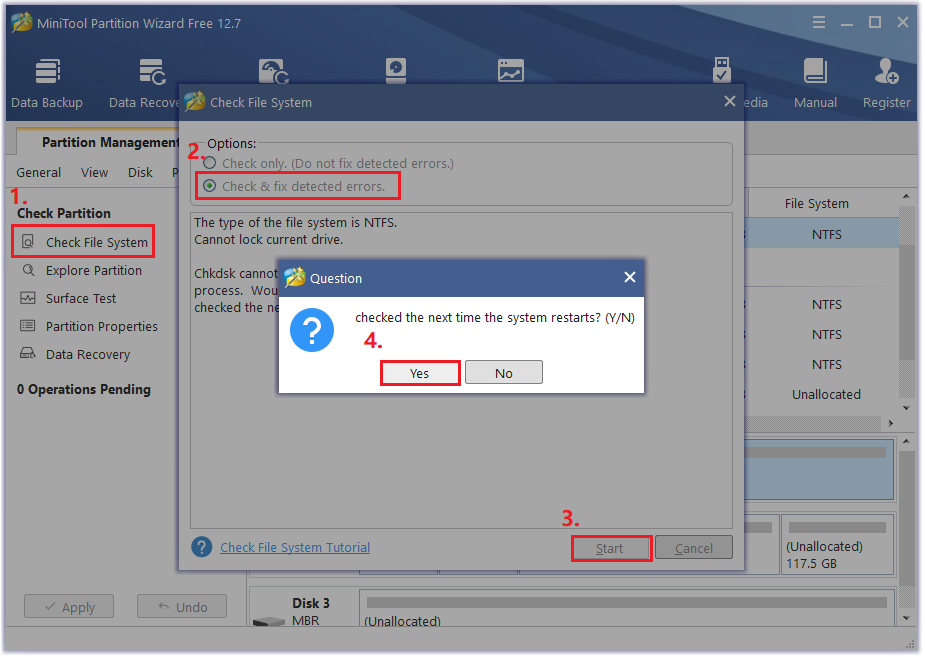
Here’s the guide for Surface Test:
- Launch MiniTool Partition Wizard into its main interface.
- Select the partition you want to check, and then click on the Surface Test option from the left panel.
- Click on the Start Now button to start the scanning process. If there are any bad sectors, they will be marked in red color.
- If there are too many red blocks, you need to replace the disk. But if there are just a bit of red blocks, you can mark them as unreadable or shield them with third-party software.

Method 11. Temporary Remove Peripheral Devices
Some people report that temporarily removing peripheral devices helps them fix the Bug Check 0xA4 CNSS_FILE_SYSTEM_FILTER error successfully. You can also have a try. To do that, you just need to remove the accessories temporarily, leave them for a few minutes, and then connect them again.
Method 12. Clean the Hard Disk Space
If there are too many caches on your PC, you may also encounter the Bug Check 0xA4 CNSS_FILE_SYSTEM_FILTER error. In this case, you can try running the Disk Cleanup tool to clear the caches on your PC to fix the error. Here’s the tutorial:
- Press the Windows and R keys simultaneously to open the Run window.
- Type “cleanmgr” in the box and press Enter.
- In the Disk Cleanup: Drive Selection window, select C drive and click OK.
- Next, check the box in front of the files you want to clear and click the OK button.
- Click the Delete Files button in the pop-up window.
- Once done, check if the error is fixed.
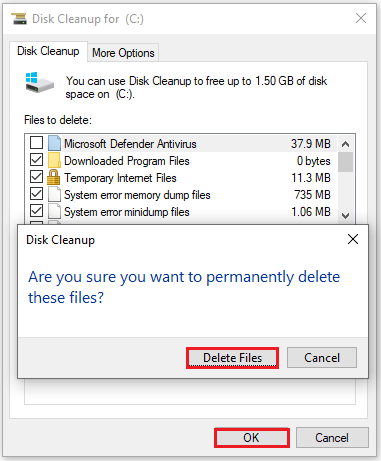
Method 13. Update BIOS
Outdated BIOS can also cause the Bug Check 0xA4 CNSS_FILE_SYSTEM_FILTER error. So, you can try updating the BIOS on your PC to fix this error. If you want to have a try, you can follow the guide in this post: How to Update BIOS Windows 10 | How to Check BIOS Version.
However, updating the BIOS may sometimes result in data loss. Therefore, backing up the data on your PC before you update your BIOS is very necessary. To make a backup, you can refer to this post: [Guide] How to Back up Your Computer to an External Drive
Method 14. Performing a System Restore
Windows often creates a restore point before automatically installing the monthly updates, so you can roll it back when you encounter errors. You can try running system restore to fix the CNSS_FILE_SYSTEM_FILTER error. Here’s how to do it:
- Boot your PC in safe mode.
- Navigate to Settings > System > About.
- Click on the System Protection link on the right panel.
- Under the System Protection tab, click on the System Restore button.
- Then click Next on the new pop-up window.
- Select a restore point you wish to use and click Next.
- Now, wait for this process to complete.
- Once done, check if the issue has been resolved.
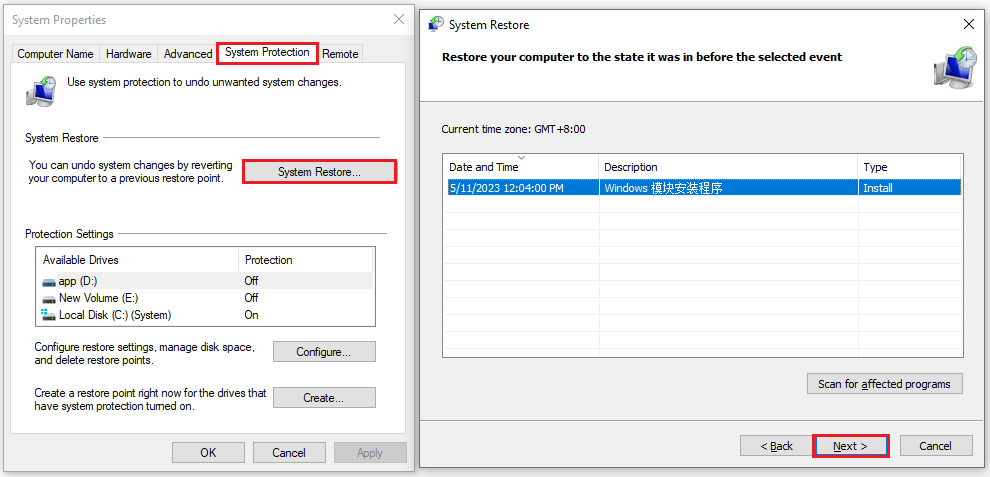
Wrapping Things up
This post shows you how to fix the CNSS_FILE_SYSTEM_FILTER BSOD error. You can choose corresponding solutions according to your situation.
If you have any confusion or options about this topic, share them with us in the following comment area. Also, you can send us an email at [email protected] if you have difficulty using MiniTool Partition Wizard. We will get back to you as soon as possible.

User Comments :